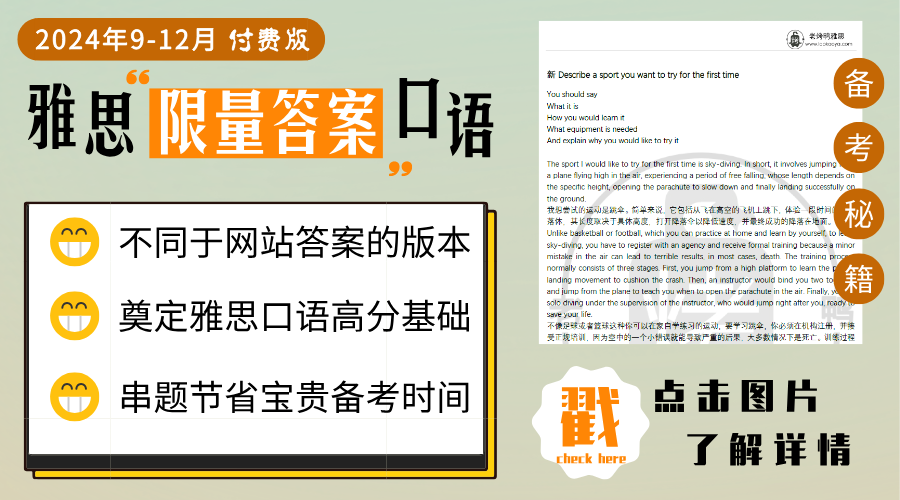剑桥雅思8Test2阅读Passage1答案解析 Sheet glass manufacture: the f […]

剑桥雅思8Test2阅读Passage1答案解析 Sheet glass manufacture: the float process 平板玻璃制造
剑桥雅思8阅读第二套题目第一篇文章的13道题目由5道表格填空,3道图例填空,以及6道TRUE/FALSE/NOT GIVEN判断构成。整体难度不算太大。下面是具体每道题目的答案解析。
点击查看这篇雅思阅读中出现的重点词汇以及对应的原文翻译:
雅思真题阅读词汇 剑桥雅思8 test 2 passage 1 玻璃板制造
剑桥雅思8Test2阅读Passage1原文翻译 sheet glass manufacture: the float process
剑桥雅思8 Test 2 Passage 1阅读答案解析第1题答案:spinning
对应原文:第1段:The first successful method for making clear, flat glass involved spinning.
答案解析:文中一共就提到三种制作玻璃的方式,根据method定位到第1段的这句话,很容易确定答案为spinning。
第2题答案:(perfectly) unblemished
对应原文:第1段:so it stayed perfectly unblemished
答案解析:根据题干,空上应该填remained的对象,原文中stay与remain同义替换,由此确定答案为unblemished。
第3题答案:labour-intensive
对应原文:第1段:However, the process took a long time and was labour intensive
答案解析:根据slow与took a long time的对应定位到第一段的这句话,与之并列的只有labour intensive,由此确定答案。
第4题答案:thickness
对应原文:第2段: This allowed glass of virtually any thickness
答案解析:根据前一单元格的ribbon定位到第二段。这一段的前两句文章来自老烤鸭雅思都是在介绍具体的方法,第三句才提到优势。空前词varying跟原文中的any对应,由此确定答案为thickness。
第5题答案:marked
对应原文:第2段:but the rollers would leave both sides of the glass marked
答案解析:从表头的disadvantages推断出空上应该填缺点。原文说完任何厚度的有点之后,用了but一词进行转折,由此确定句子。空上应该填形容词,用来说明玻璃的某种状态,锁定marked。
第6题答案:(molten) glass
对应原文:第4段:Consequently, when pouring molten glass onto the molten tin
答案解析:原文中第3段描述Pilkington的观点,第4段开始文章来自老烤鸭雅思介绍其具体流程。第6题应该是填倒进melting zone的什么东西,对应原文中pouring,由此确定molten glass为答案。
第7题答案:(molten) tin/metal
对应原文:第4段:Consequently, when pouring molten glass onto the molten tin
答案解析:从图中可以看出,空上应该填支撑融化玻璃的东西,对应原文中的onto,由此确定答案为molten tin。
第8题答案:rollers
对应原文:第4段:and could be transported out of the cooling zone by rollers
答案解析:从图中就可以看出第8题应该填的是滚轮一类的东西,负责将做好的玻璃传送出去,这正好对应原文中的transported out,由此确定答案为rollers。
第9题答案:TRUE
对应原文:第3段:The metal had to melt at a temperature less than the hardening point of glass (about 600~C), but this article is from Laokaoya website, could not boil at a temperature below the temperature of the molten glass (about 1500~C).
答案解析:原文中提到,该金属必须在600度以下融化,但由不能在1500度以下沸腾,即它必须拥有一定的特性。由此确定答案为TRUE。
第10题答案:NOT GIVEN
对应原文:第5段:Pilkington built a pilot plant in 1953 and by 1955 he had convinced his company to build a full-scale plant.
答案解析:原文中只是提到Pilkington自己在1953年建立了试验性质的厂房,有在1955年说服公司建立全面的工厂,并没有说他自己投没投钱,因此确定答案为NOT GIVEN。
第11题答案:FALSE
对应原文:第5段:However, it took 14 months of non-stop production, costing the company £100, 000 a month, before the plant produced any usable glass
答案解析:原文中提到,工厂用了14个月进行不间断的生产,每个月花费100000英镑,随后才终于制造出可用的玻璃。可见该工厂并不是立刻就成功的。题干中的描述与此相反,由此确定答案为FALSE。
第12题答案:TRUE
对应原文:第7段:However, the product has changed dramatically, from a single thickness of 6. 8 mm to a range from sub-millimetre to 25 mm, from a ribbon frequently marred by inclusions and bubbles to almost optical perfection.
答案解析:原文中提到,玻璃有了巨大的变化。首先从单一的6.8毫米的厚度变为从亚微米到25毫米的各种厚度,其次从经常包含杂质和气泡的玻璃板几乎达到光学上的完美状态。即Pilkington的流程经过了改善,由此确定答案为TRUE。
第13题答案:TRUE
对应原文:第7段:Inspection technology allows more than 100 million measurements a second to be made across the ribbon, locating flaws the unaided eye would be unable to see
答案解析:原文中提到,检测科技每秒测量玻璃板一亿次,能够定位到人类眼睛无法看到的缺陷。可见计算机比人类在检测缺陷方面要更好一些。由此确定答案为TRUE。
剑桥雅思8Test2阅读Passage2答案解析 the little ice age 小冰期/小冰河时代
剑桥雅思8Test2阅读Passage3答案解析 The meaning and power of smell 气味的意义与力量
